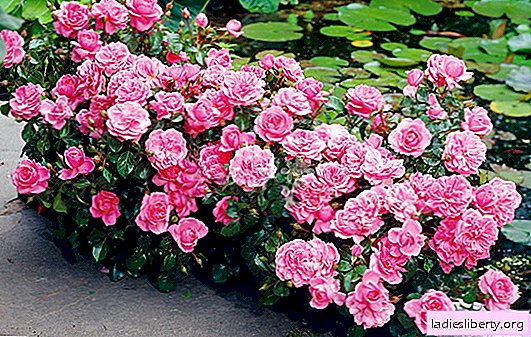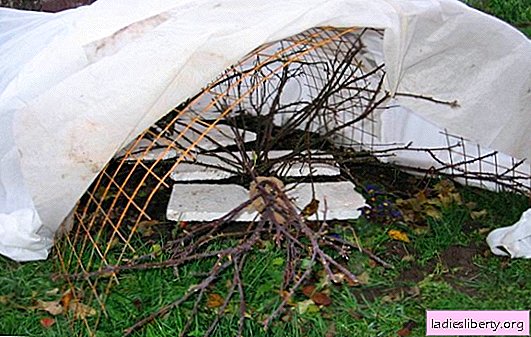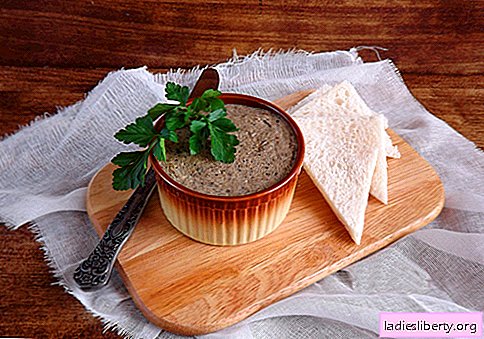
In the last century, the Danish breeder Svend Poulsen crossed polyanthus roses with tea species of this flower and obtained hybrids with perfectly matching parental characteristics.
By the magnificence of inflorescences and their resistance to adverse conditions, they resembled polyanthus roses entirely, and the shape and size of flowers resembled tea hybrids.
Subsequently, from the constant crossings of the above species with other groups of garden roses, varieties emerged that were combined into the Floribund group, which means - abundantly or gratefully blooming.
Rose Floribunda and features of its cultivation
In order for such a gorgeous beauty like the Floribunda rose to take root in your monastery, you need to know some rules and take into account the peculiarities of its cultivation:
• It is necessary to select high-quality material for planting such a capricious and delicate flower as the Floribunda rose, mainly acquired in reliable nurseries.
• It is more advisable to plant this rose during the late spring and early summer, but you can plant, and in the autumn, this option is available only to residents of the southern regions of Russia.
• To plant a rose, you must use a well-lit, warm place.
• You also need to prepare a fertilized planting hole and properly plant the roses.
• Cut the flower in time and do not overdo it with water while watering it.
• It is necessary to fertilize the plant, and for the winter to close the plant from frost and cold.
Rose Floribunda varieties and variety of plant species
Roses of Floribunda with their colorfulness and flower shape are very similar to their congeners of tea-hybrid plant species, with the only difference being that their flowering is more abundant and almost continuous.
The flowers of this rose are double and strongly double with a flat, cupped and goblet shape.
Rose Floribunda varieties and the best representatives of this group:
• Lilly Marlene - has a fiery red inflorescence with a diameter reaching 7-8 cm. A bush of this type of rose is compact having a height of 70-75 cm.
• Galaxy - a type of rose having buds at the beginning of flowering with the color of orange-yellow inflorescences and reaching, during full bloom, a creamy shade of a fragrant flower. A bushy and sprawling plant reaches a height of 60-80 cm.
• Nicolo Paganini - rich red inflorescences sometimes have up to 12 flowers with velvety tender petals. The bushes have abundant foliage and reach up to 80 cm in height.
• Diadem - an elegant-looking form of a rose, with a soft pinkish tint filled with brushes, on which there are 8-10 fragrant and beautiful flowers. In height, a mighty bush, such a delicate flower can reach 90 cm.
• Shocking blue - has a large inflorescence, painted in pale purple. The plant reaches a height of 70-80 cm and has abundant bright green foliage.
• Friesia - a rose with bright yellow terry petals, has a rich aroma. The bushes of this plant are dense and neat with a stem reaching a length of up to 70 cm.
• Blue Baju - a rose with an original color, namely large inflorescences with blue and lilac petals. Pretty delicate Floribunda variety, vulnerable to temperature extremes and humidity.
Rose Floribunda varieties and their individual characteristics are original and inimitable.
Rose Floribunda planting and preparation for it
The process of growing this rose is simple - the plant is unpretentious and easily takes root. To plant this flower, it is necessary to deepen into the ground by 3 cm. Before proceeding to planting roses, you must first prepare the ground for this.
To do this, you need to take sand, humus and peat in a bucket of each component, add to them half the same capacity of small clay, a little bone meal and superphosphate fertilizer.
All of the above components need to be poured into the pit, and when the Floribunda roses planting is completed, the earth with the flower must be carefully shed, sprinkled on top with sawdust, to better retain moisture.

Rose Floribunda and planting it with cuttings is carried out for its better survival. Already woody shoots, cut into cuttings that have a length of not more than 10 cm, are lowered into the earthen hole almost half. The distance between the cuttings should be about 30 cm. One of the sides of the pit needs to be made vertical so that the stalk of the plant will be straight and even in the future.
After planting, seedlings must be covered with a film.
Important! For Floribunda rose, it is necessary to select areas that are well lit and protected from winds and drafts.
Rose Floribunda Care and Growing
Rosa Floribunda care, as well as its watering, top dressing, weeding from weeds, pruning and shaping must comply with certain rules for growing this flower.
Watering
Watering these roses requires regular and plentiful, especially in the hot season. Watering these flowers is advisable in the evening, when the water does not attract the sun's rays, as a result of which the flowers will not be able to get burns.

Top dressing
Floribunda loves top dressing; during the planting period, it is necessary to fertilize the earth with humus. After pruning, the flower must be fed with mineral fertilizers. Further top dressing must be carried out at the beginning of spring with nitrogen-containing fertilizers. Organic fertilizers are regularly applied during the entire flowering period.
Pruning
To keep the bushes updated all the time, it is necessary to prune Floribunda's roses at some intervals. Usually pruned plant in autumn and spring. But the most important pruning is considered spring, since the formation of a rose bush depends on it.
Pruning is of a strong type and medium, it all depends on the ability of the rose to recover and the possibility of its birth of new shoots. Pruning made in the spring, allows the rose to bloom earlier, due to the normal development of shoots. Medium circumcision is performed on 4-6 eyes. And the rose Floribunda has a chance to delight the gardener with her flowering throughout the summer period.
Due to the strong pruning, the shoots are significantly extended. And bloom will begin only at the end of summer or even with the onset of autumn.
Basic pruning rules:
• Circumcision can be performed throughout the season.
• Trim the top of the bush.
• On the rose after pruning, leave no more than 5 shoots, 10 cm.
• When trimming medium, leave no more than 6 kidneys.
• If there are lateral processes on the main shoot, then they need to be shortened.
• For a beautiful appearance of the bush, the buds must be left outside the bush.
• If the shoots are more than 2 years old, they must be cut.
Important! Since the Floribunda rose blooms all season, when pruning, it is necessary to remove all dry and damaged branches from it. And leave healthy and strong shoots.
Shelter
Rose Floribunda, care for which is not so complicated, still requires a careful and attentive attitude towards her.
In order to save the rosette from the cold, it needs to be covered, but first you need to:
• Take all the leaves and inflorescences from the branches.
• Trim the bushes.
• Carry out earthing up.
• Cover with leaflets on top.
• Cover with special material.
Rose Floribunda can be grown both in the garden and at home, say on the windowsill. But here you also need to know about the features of its cultivation. These roses are loved when they are placed on the windowsills, whose windows face south. In addition, during the growing season, these roses need nutritious soil and regular watering. Although these flowers do not like excess water. You need to feed a rose at home once every 7 days during the period of development and flowering.
Important! If the rose has a small pot, then it must be transplanted into a more spacious container, since the root system needs space.
Often these roses are planted on flower beds. These beautiful roses look great in group plantings, especially when using three or more varieties. The distance assumed between the bushes depends on the varieties of the flower and the selected composition.
Diseases and pests of the rose
Diseases and pests of the Floribunda rose:
• Rose stem cancer is an infectious disease caused by ascomycetes. The disease captures the stems of roses, forming brown blotches on them. Stems affected by cancer must be cut off and then treated with copper sulfate.
• Aphid, striking roses because of which the flower can easily die. In the fight against this pest, you can control it by collecting aphids with your hands.
• Rust on roses - after infection with this disease, the flower will not be able to recover and die. Therefore, regular prevention of this disease is necessary. Create favorable conditions and provide proper care for your pets.

It so happens that on the leaves of roses appear "painful" places, spots, and the flowers themselves begin to fade. Having noticed this, the painful shoots must be urgently removed. It is recommended to neutralize the soil under the plant for prevention from various metals and other impurities by using limestone or dolomite flour.
It is also necessary to avoid acidification of the soil, in connection with the possible death of the plant.
It is very important to protect the roses of the Floribund group, because among them there are very delicate and fragile varieties that are affected by poor-quality care (improper watering, top dressing, cutting) of the plant contrary to the existing rules for growing and inability to protect the flower from possible pests and diseases.
Save











